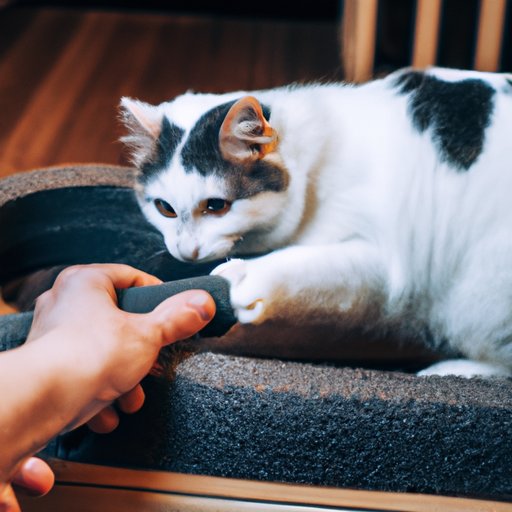
I. Introduction
Cats are a beloved pet for millions of people around the world. However, one common issue that many cat owners face is their cat scratching furniture. This can be frustrating, not only because furniture can be expensive to replace but also because scratching can cause damage to the home. In this comprehensive guide, we will explore various strategies to stop cats from scratching your furniture.
II. Provide Alternative Scratching Surfaces
One of the main reasons why cats scratch furniture is to sharpen their claws and stretch their bodies. Therefore, it is essential to provide alternative scratching surfaces. Scratching posts or boards are an excellent choice because they provide a dedicated space for cats to scratch without damaging your furniture.
When choosing a scratching post, make sure it is tall enough for your cat to fully stretch its body, stable enough that it won’t fall over, and made of a material that feels good on their claws, such as sisal. Place it in an area where your cat spends a lot of time, or near the furniture they like to scratch.
III. Apply a Cat Repellent Spray
Cat repellent spray can be an effective way to deter cats from scratching furniture. These sprays usually contain natural scents that are unpleasant to cats but won’t harm them. Alternatively, you can make a homemade spray using essential oils, such as citrus, lavender, or eucalyptus oil, mixed with water.
It is essential to note that while repellent sprays can be effective, they may not work for all cats. Consistency is also crucial when using the spray. Apply the spray to the furniture that your cat likes to scratch, and reapply every few days.
IV. Provide a Comfortable Sleeping Area
Stress and boredom can also lead to destructive scratching behavior in cats. Providing a cozy sleeping area is a great way to reduce stress and boredom. Cats enjoy sleeping in soft, warm, and enclosed spaces, such as a cat bed or a cardboard box.
When choosing a sleeping area, consider your cat’s preference. Some cats prefer high locations, while others prefer low. Try to place the sleeping area in a quiet and peaceful place, away from high-traffic areas and loud noises.
V. Trim their Nails
Nail trimming is essential for cats because it helps prevent damage to furniture and other items. It is also essential for their hygiene and health. Trim your cat’s nails regularly using cat-specific nail clippers, and make sure to avoid cutting the quick, which is a blood vessel in the nail.
The frequency of nail trimming depends on the cat’s activity level and how fast their nails grow. Some cats may need their nails trimmed every two weeks, while others may only need it once a month.
VI. Playtime
Playtime is essential for cats because it provides exercise, stimulation, and reduces stress. Engage your cat in interactive playtime by using toys that encourage them to chase, pounce, and jump. Interactive toys like feather wands, laser pointers, or catnip toys are great choices.
Remember to keep playtime short and frequent, as prolonged playtime can lead to exhaustion and overstimulation. Also, try to vary the toys you use to keep your cat interested and engaged.
VII. Use Double-Sided Tape
Double-sided tape is an effective way to discourage cats from scratching furniture because it is sticky and uncomfortable for them. Apply it to the areas of the furniture that your cat likes to scratch, and they will avoid it. You can also purchase specialty tapes designed specifically for this purpose.
However, not all cats are deterred by double-sided tape, and it may not be effective for all cats. Make sure to choose an appropriate tape that won’t damage your furniture or leave a sticky residue.
VIII. Use Negative Reinforcement
Negative reinforcement is a technique that involves teaching a cat that their behavior has consequences. For example, when your cat scratches furniture, you can make a loud, unpleasant noise that will startle them and discourage this behavior. However, it is important to use this technique safely and appropriately, and only as a last resort after other techniques have failed.
Consistency and timing are also crucial when using negative reinforcement. It is essential to provide the consequence immediately after the unwanted behavior without punishing the cat directly.
IX. Conclusion
Scratching furniture is a common behavior in cats, but it can be frustrating for their owners. This comprehensive guide has provided various tips and strategies to stop cats from scratching furniture, including alternative scratching surfaces, cat repellent sprays, comfortable sleeping areas, nail trimming, playtime, double-sided tape, and negative reinforcement. Remember that patience and consistency are essential when training your cat. With proper care and attention, you can prevent destructive cat behavior and maintain a healthy and happy relationship with your furry friend.




